Lancia Musa 2010 Owner handbook (in English)
Manufacturer: LANCIA, Model Year: 2010, Model line: Musa, Model: Lancia Musa 2010Pages: 218, PDF Size: 3.71 MB
Page 91 of 218
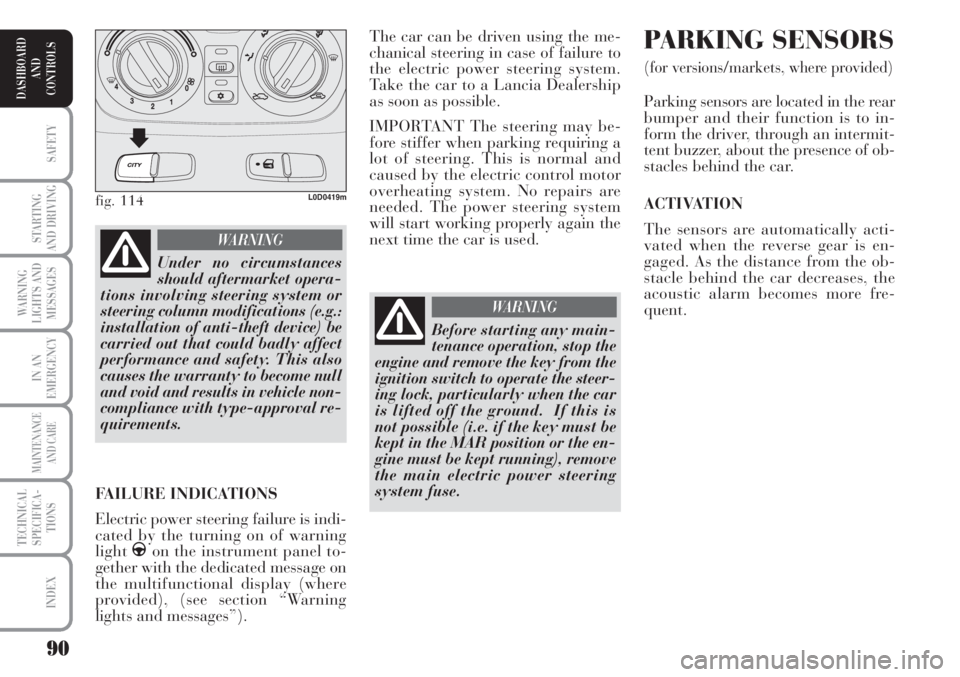
90
SAFETY
STARTING
AND DRIVING
WARNING
LIGHTS AND
MESSAGES
IN AN
EMERGENCY
MAINTENANCE
AND CARE
TECHNICAL
SPECIFICA-
TIONS
INDEX
DASHBOARD
AND
CONTROLS
The car can be driven using the me-
chanical steering in case of failure to
the electric power steering system.
Take the car to a Lancia Dealership
as soon as possible.
IMPORTANT The steering may be-
fore stiffer when parking requiring a
lot of steering. This is normal and
caused by the electric control motor
overheating system. No repairs are
needed. The power steering system
will start working properly again the
next time the car is used. PARKING SENSORS
(for versions/markets, where provided)
Parking sensors are located in the rear
bumper and their function is to in-
form the driver, through an intermit-
tent buzzer, about the presence of ob-
stacles behind the car.
ACTIVATION
The sensors are automatically acti-
vated when the reverse gear is en-
gaged. As the distance from the ob-
stacle behind the car decreases, the
acoustic alarm becomes more fre-
quent.
fig. 114L0D0419m
Under no circumstances
should aftermarket opera-
tions involving steering system or
steering column modifications (e.g.:
installation of anti-theft device) be
carried out that could badly affect
performance and safety. This also
causes the warranty to become null
and void and results in vehicle non-
compliance with type-approval re-
quirements.
WARNING
FAILURE INDICATIONS
Electric power steering failure is indi-
cated by the turning on of warning
light
gon the instrument panel to-
gether with the dedicated message on
the multifunctional display (where
provided), (see section “Warning
lights and messages”).
Before starting any main-
tenance operation, stop the
engine and remove the key from the
ignition switch to operate the steer-
ing lock, particularly when the car
is lifted off the ground. If this is
not possible (i.e. if the key must be
kept in the MAR position or the en-
gine must be kept running), remove
the main electric power steering
system fuse.
WARNING
Page 92 of 218
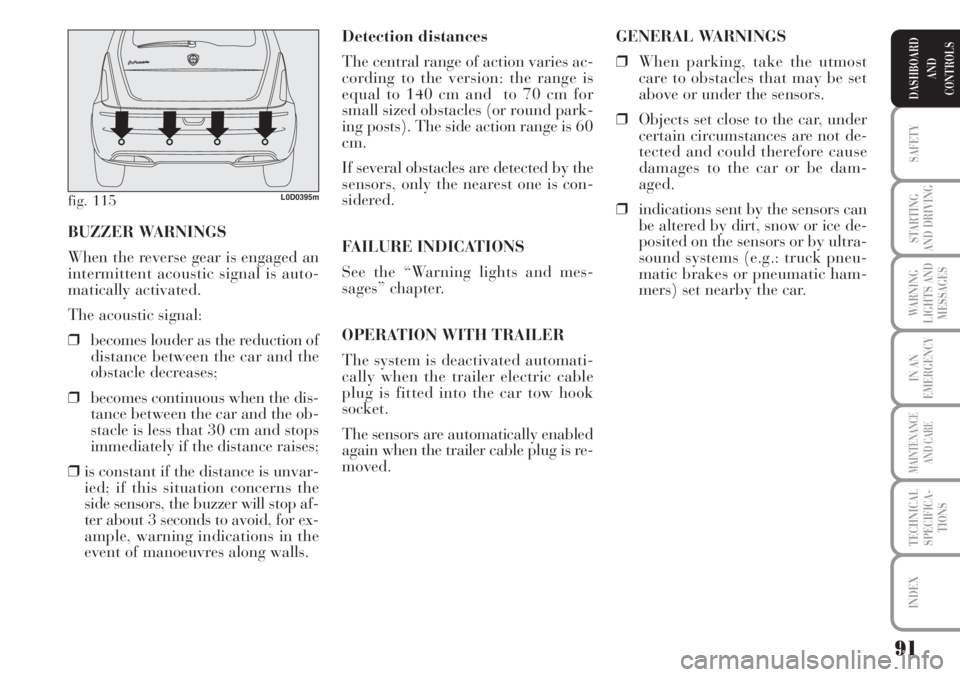
91
SAFETY
STARTING
AND DRIVING
WARNING
LIGHTS AND
MESSAGES
IN AN
EMERGENCY
MAINTENANCE
AND CARE
TECHNICAL
SPECIFICA-
TIONS
INDEX
DASHBOARD
AND
CONTROLS
Detection distances
The central range of action varies ac-
cording to the version: the range is
equal to 140 cm and to 70 cm for
small sized obstacles (or round park-
ing posts). The side action range is 60
cm.
If several obstacles are detected by the
sensors, only the nearest one is con-
sidered.
FAILURE INDICATIONS
See the “Warning lights and mes-
sages” chapter.
OPERATION WITH TRAILER
The system is deactivated automati-
cally when the trailer electric cable
plug is fitted into the car tow hook
socket.
The sensors are automatically enabled
again when the trailer cable plug is re-
moved. BUZZER WARNINGS
When the reverse gear is engaged an
intermittent acoustic signal is auto-
matically activated.
The acoustic signal:
❒becomes louder as the reduction of
distance between the car and the
obstacle decreases;
❒becomes continuous when the dis-
tance between the car and the ob-
stacle is less that 30 cm and stops
immediately if the distance raises;
❒is constant if the distance is unvar-
ied; if this situation concerns the
side sensors, the buzzer will stop af-
ter about 3 seconds to avoid, for ex-
ample, warning indications in the
event of manoeuvres along walls.
fig. 115L0D0395m
GENERAL WARNINGS
❒When parking, take the utmost
care to obstacles that may be set
above or under the sensors.
❒Objects set close to the car, under
certain circumstances are not de-
tected and could therefore cause
damages to the car or be dam-
aged.
❒indications sent by the sensors can
be altered by dirt, snow or ice de-
posited on the sensors or by ultra-
sound systems (e.g.: truck pneu-
matic brakes or pneumatic ham-
mers) set nearby the car.
Page 93 of 218
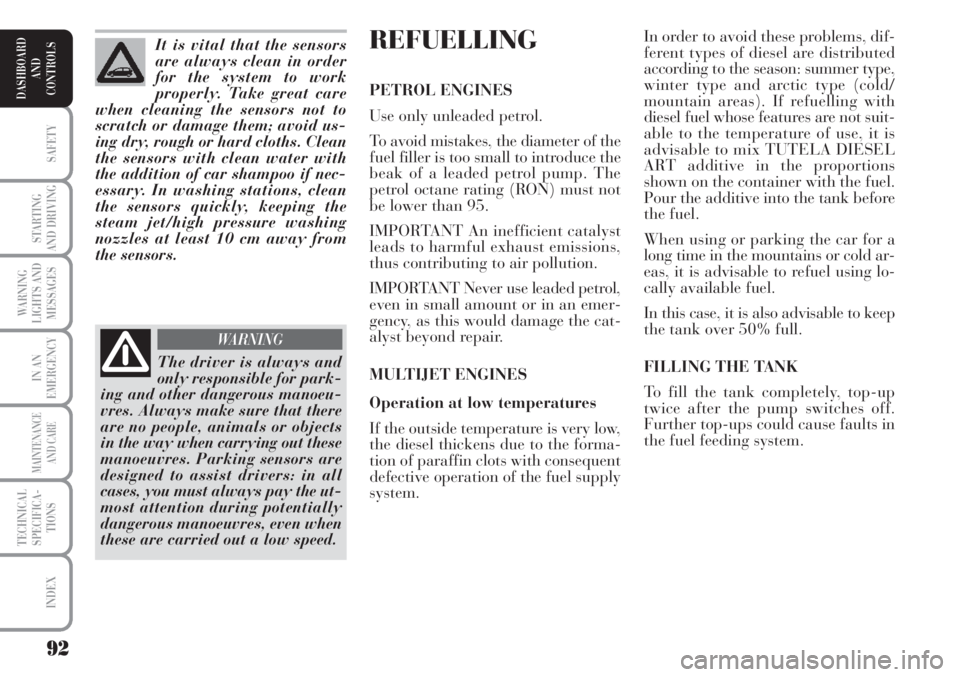
92
SAFETY
STARTING
AND DRIVING
WARNING
LIGHTS AND
MESSAGES
IN AN
EMERGENCY
MAINTENANCE
AND CARE
TECHNICAL
SPECIFICA-
TIONS
INDEX
DASHBOARD
AND
CONTROLS
REFUELLING
PETROL ENGINES
Use only unleaded petrol.
To avoid mistakes, the diameter of the
fuel filler is too small to introduce the
beak of a leaded petrol pump. The
petrol octane rating (RON) must not
be lower than 95.
IMPORTANT An inefficient catalyst
leads to harmful exhaust emissions,
thus contributing to air pollution.
IMPORTANT Never use leaded petrol,
even in small amount or in an emer-
gency, as this would damage the cat-
alyst beyond repair.
MULTIJET ENGINES
Operation at low temperatures
If the outside temperature is very low,
the diesel thickens due to the forma-
tion of paraffin clots with consequent
defective operation of the fuel supply
system.In order to avoid these problems, dif-
ferent types of diesel are distributed
according to the season: summer type,
winter type and arctic type (cold/
mountain areas). If refuelling with
diesel fuel whose features are not suit-
able to the temperature of use, it is
advisable to mix TUTELA DIESEL
ART additive in the proportions
shown on the container with the fuel.
Pour the additive into the tank before
the fuel.
When using or parking the car for a
long time in the mountains or cold ar-
eas, it is advisable to refuel using lo-
cally available fuel.
In this case, it is also advisable to keep
the tank over 50% full.
FILLING THE TANK
To fill the tank completely, top-up
twice after the pump switches off.
Further top-ups could cause faults in
the fuel feeding system. It is vital that the sensors
are always clean in order
for the system to work
properly. Take great care
when cleaning the sensors not to
scratch or damage them; avoid us-
ing dry, rough or hard cloths. Clean
the sensors with clean water with
the addition of car shampoo if nec-
essary. In washing stations, clean
the sensors quickly, keeping the
steam jet/high pressure washing
nozzles at least 10 cm away from
the sensors.
The driver is always and
only responsible for park-
ing and other dangerous manoeu-
vres. Always make sure that there
are no people, animals or objects
in the way when carrying out these
manoeuvres. Parking sensors are
designed to assist drivers: in all
cases, you must always pay the ut-
most attention during potentially
dangerous manoeuvres, even when
these are carried out a low speed.
WARNING
Page 94 of 218
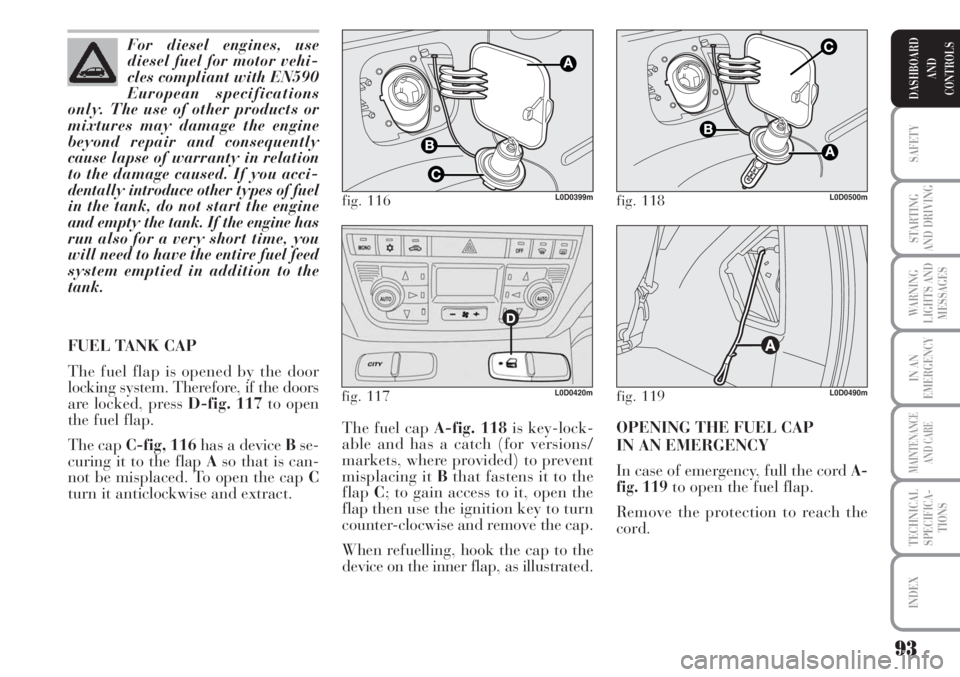
93
SAFETY
STARTING
AND DRIVING
WARNING
LIGHTS AND
MESSAGES
IN AN
EMERGENCY
MAINTENANCE
AND CARE
TECHNICAL
SPECIFICA-
TIONS
INDEX
DASHBOARD
AND
CONTROLS
The fuel cap A-fig. 118is key-lock-
able and has a catch (for versions/
markets, where provided) to prevent
misplacing it Bthat fastens it to the
flapC; to gain access to it, open the
flap then use the ignition key to turn
counter-clocwise and remove the cap.
When refuelling, hook the cap to the
device on the inner flap, as illustrated.OPENING THE FUEL CAP
IN AN EMERGENCY
In case of emergency, full the cord
A-
fig. 119to open the fuel flap.
Remove the protection to reach the
cord. For diesel engines, use
diesel fuel for motor vehi-
cles compliant with EN590
European specifications
only. The use of other products or
mixtures may damage the engine
beyond repair and consequently
cause lapse of warranty in relation
to the damage caused. If you acci-
dentally introduce other types of fuel
in the tank, do not start the engine
and empty the tank. If the engine has
run also for a very short time, you
will need to have the entire fuel feed
system emptied in addition to the
tank.
FUEL TANK CAP
The fuel flap is opened by the door
locking system. Therefore, if the doors
are locked, press D-fig. 117to open
the fuel flap.
The cap C-fig, 116has a device Bse-
curing it to the flap Aso that is can-
not be misplaced. To open the cap C
turn it anticlockwise and extract.
fig. 116L0D0399m
fig. 119L0D0490mfig. 117L0D0420m
fig. 118L0D0500m
Page 95 of 218
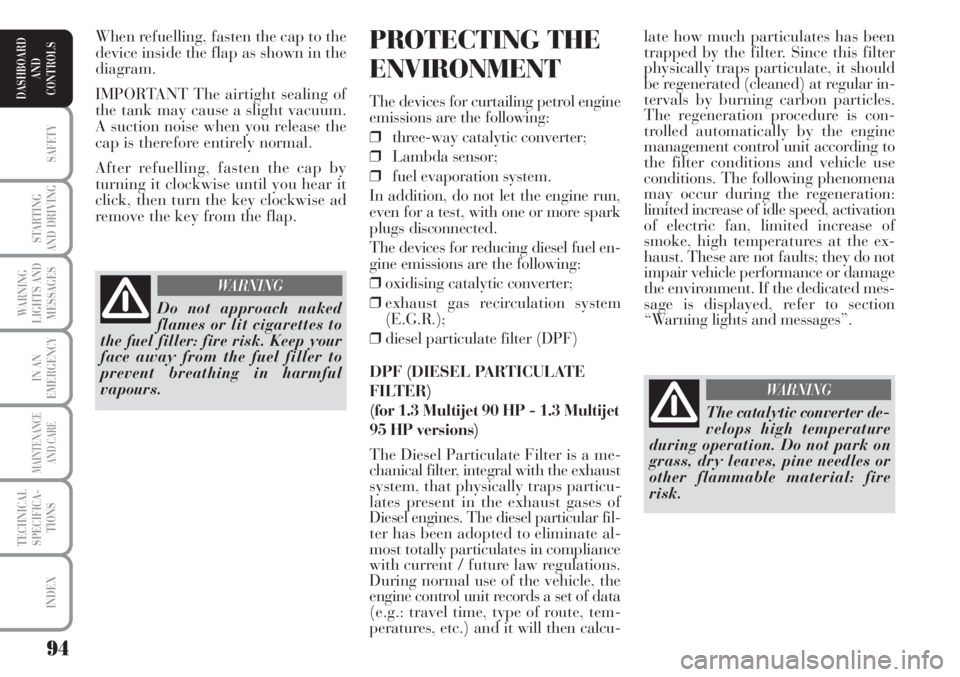
94
SAFETY
STARTING
AND DRIVING
WARNING
LIGHTS AND
MESSAGES
IN AN
EMERGENCY
MAINTENANCE
AND CARE
TECHNICAL
SPECIFICA-
TIONS
INDEX
DASHBOARD
AND
CONTROLS
late how much particulates has been
trapped by the filter. Since this filter
physically traps particulate, it should
be regenerated (cleaned) at regular in-
tervals by burning carbon particles.
The regeneration procedure is con-
trolled automatically by the engine
management control unit according to
the filter conditions and vehicle use
conditions. The following phenomena
may occur during the regeneration:
limited increase of idle speed, activation
of electric fan, limited increase of
smoke, high temperatures at the ex-
haust. These are not faults; they do not
impair vehicle performance or damage
the environment. If the dedicated mes-
sage is displayed, refer to section
“Warning lights and messages”.PROTECTING THE
ENVIRONMENT
The devices for curtailing petrol engine
emissions are the following:
❒three-way catalytic converter;
❒Lambda sensor;
❒fuel evaporation system.
In addition, do not let the engine run,
even for a test, with one or more spark
plugs disconnected.
The devices for reducing diesel fuel en-
gine emissions are the following:
❒oxidising catalytic converter;
❒exhaust gas recirculation system
(E.G.R.);
❒diesel particulate filter (DPF)
DPF (DIESEL PARTICULATE
FILTER)
(for 1.3 Multijet 90 HP - 1.3 Multijet
95 HP versions)
The Diesel Particulate Filter is a me-
chanical filter, integral with the exhaust
system, that physically traps particu-
lates present in the exhaust gases of
Diesel engines. The diesel particular fil-
ter has been adopted to eliminate al-
most totally particulates in compliance
with current / future law regulations.
During normal use of the vehicle, the
engine control unit records a set of data
(e.g.: travel time, type of route, tem-
peratures, etc.) and it will then calcu- When refuelling, fasten the cap to the
device inside the flap as shown in the
diagram.
IMPORTANT The airtight sealing of
the tank may cause a slight vacuum.
A suction noise when you release the
cap is therefore entirely normal.
After refuelling, fasten the cap by
turning it clockwise until you hear it
click, then turn the key clockwise ad
remove the key from the flap.
Do not approach naked
flames or lit cigarettes to
the fuel filler: fire risk. Keep your
face away from the fuel filler to
prevent breathing in harmful
vapours.
WARNING
The catalytic converter de-
velops high temperature
during operation. Do not park on
grass, dry leaves, pine needles or
other flammable material: fire
risk.
WARNING
Page 96 of 218
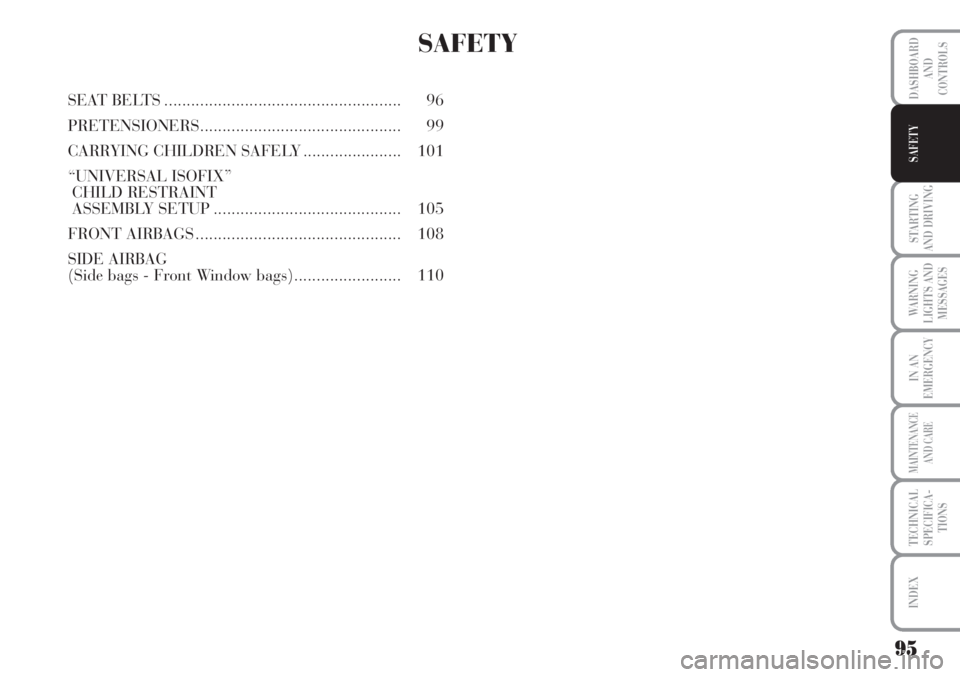
95
STARTING
AND DRIVING
WARNING
LIGHTS AND
MESSAGES
IN AN
EMERGENCY
MAINTENANCE
AND CARE
TECHNICAL
SPECIFICA-
TIONS
INDEX
DASHBOARD
AND
CONTROLS
SAFETY
SAFETY
SEAT BELTS ..................................................... 96
PRETENSIONERS............................................. 99
CARRYING CHILDREN SAFELY ...................... 101
“UNIVERSAL ISOFIX”
CHILD RESTRAINT
ASSEMBLY SETUP.......................................... 105
FRONT AIRBAGS.............................................. 108
SIDE AIRBAG
(Side bags - Front Window bags)........................ 110
Page 97 of 218

96
STARTING
AND DRIVING
WARNING
LIGHTS AND
MESSAGES
IN AN
EMERGENCY
MAINTENANCE
AND CARE
TECHNICAL
SPECIFICA-
TIONS
INDEX
DASHBOARD
AND
CONTROLS
SAFETY
SEAT BELTS
USING THE FRONT
AND SIDE REAR
SEAT BELTS
The belt should be worn keeping the
chest straight and rested against the
seat back.
To fasten the seat belts, take hold the
tongueA-fig. 1and insert it into the
buckleB, until hearing the locking
click.
On removal, if it jams, let it rewind
for a short stretch, then pull it out
again without jerking.
Press button Cto release the belt. Ac-
company the belt while it is being re-
wound to prevent twisting.
Through the reel, the belt automati-
cally adapts to the body of the pas-
senger wearing it, allowing freedom of
movement.The reel may lock when the car is
parked on a steep slope: this is per-
fectly normal. Furthermore, the reel
mechanism locks the belt if it is pulled
and in the event of sudden braking,
collisions and on high speed bends.
The rear seat is fitted with inertial
seat belts with three anchor points
and reel.Rear seat belts must be worn as
shown in diagram D-fig. 2(five seat
versions) or as shown in diagram
E-fig. 3(four seat versions).
fig. 1L0D0126m
fig. 2L0D0430m
fig. 3L0D0431m
Never press button C-fig. 1
when travelling.
WARNING
Page 98 of 218

97
STARTING
AND DRIVING
WARNING
LIGHTS AND
MESSAGES
IN AN
EMERGENCY
MAINTENANCE
AND CARE
TECHNICAL
SPECIFICA-
TIONS
INDEX
DASHBOARD
AND
CONTROLS
SAFETY
S.B.R. system
The car is fitted with a Seat Belt Re-
minder system (S.B.R.), consisting of
a buzzer and a flashing warning light
must be fastened.
The buzzer can be deactivated (until
the next engine stop) as follows:
❒fasten the driver’s seat belt;
❒turn the ignition key to MAR;
❒wait for over 20 seconds and then
release one of the seat belts.
For permanent deactivation, contact
a Lancia Dealership.
The S.B.R. can only be reactivated us-
ing the setup menu (see the “Warning
lights and messages” chapter, “Seat
belt reminder” paragraph).ADJUSTING THE FRONT SEAT
BELT HEIGHT
(for versions/markets, where provided)
Always adjust the seat belt height to
the passenger’s body: this precaution
may considerably reduce the risk of
injury in the event of a collision.
Correct regulation is obtained when
the belt passes approximately half
way between the shoulder and the
neck.
To adjust, move the grip A-fig. 4of
the locking mechanism either up or
down and at the same time move the
ringBto the most suitable of the al-
lowed positions.
Remember that in the
event of a violent collision,
back seat passengers not wearing
seat belts also represent a serious
danger for the front seat passen-
gers.
WARNING
fig. 4L0D0128m
The height of the seat belts
must be adjusted with the
car at a standstill.
WARNING
After adjustment, always
check that the cursor to
which the ring is fastened is locked
in one of the set positions. Release
the grip and push downwards to
enable the locking device to click if
the grip has not been released in
one of the possible positions.
WARNING
Page 99 of 218
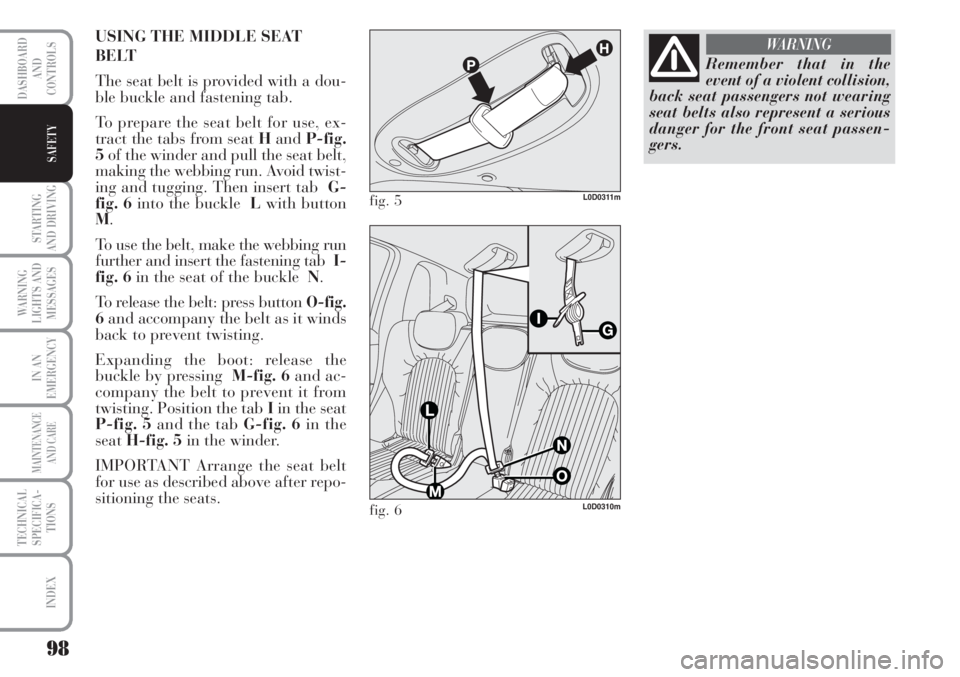
98
STARTING
AND DRIVING
WARNING
LIGHTS AND
MESSAGES
IN AN
EMERGENCY
MAINTENANCE
AND CARE
TECHNICAL
SPECIFICA-
TIONS
INDEX
DASHBOARD
AND
CONTROLS
SAFETY
USING THE MIDDLE SEAT
BELT
The seat belt is provided with a dou-
ble buckle and fastening tab.
To prepare the seat belt for use, ex-
tract the tabs from seat HandP-fig.
5of the winder and pull the seat belt,
making the webbing run. Avoid twist-
ing and tugging. Then insert tab G-
fig. 6into the buckle Lwith button
M.
To use the belt, make the webbing run
further and insert the fastening tab I-
fig. 6in the seat of the buckle N.
To release the belt: press button O-fig.
6and accompany the belt as it winds
back to prevent twisting.
Expanding the boot: release the
buckle by pressing M-fig. 6and ac-
company the belt to prevent it from
twisting. Position the tab Iin the seat
P-fig. 5and the tab G-fig. 6in the
seatH-fig. 5 in the winder.
IMPORTANT Arrange the seat belt
for use as described above after repo-
sitioning the seats.
fig. 5L0D0311m
fig. 6L0D0310m
Remember that in the
event of a violent collision,
back seat passengers not wearing
seat belts also represent a serious
danger for the front seat passen-
gers.
WARNING
Page 100 of 218
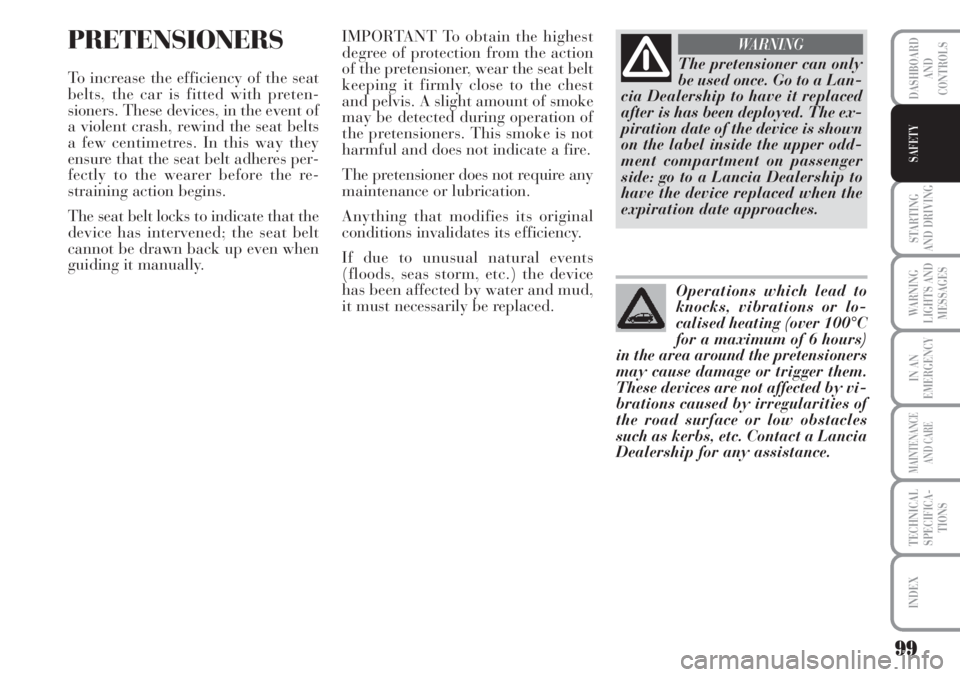
99
STARTING
AND DRIVING
WARNING
LIGHTS AND
MESSAGES
IN AN
EMERGENCY
MAINTENANCE
AND CARE
TECHNICAL
SPECIFICA-
TIONS
INDEX
DASHBOARD
AND
CONTROLS
SAFETY
PRETENSIONERS
To increase the efficiency of the seat
belts, the car is fitted with preten-
sioners. These devices, in the event of
a violent crash, rewind the seat belts
a few centimetres. In this way they
ensure that the seat belt adheres per-
fectly to the wearer before the re-
straining action begins.
The seat belt locks to indicate that the
device has intervened; the seat belt
cannot be drawn back up even when
guiding it manually.The pretensioner can only
be used once. Go to a Lan-
cia Dealership to have it replaced
after is has been deployed. The ex-
piration date of the device is shown
on the label inside the upper odd-
ment compartment on passenger
side: go to a Lancia Dealership to
have the device replaced when the
expiration date approaches.
WARNING
Operations which lead to
knocks, vibrations or lo-
calised heating (over 100°C
for a maximum of 6 hours)
in the area around the pretensioners
may cause damage or trigger them.
These devices are not affected by vi-
brations caused by irregularities of
the road surface or low obstacles
such as kerbs, etc. Contact a Lancia
Dealership for any assistance.
IMPORTANT To obtain the highest
degree of protection from the action
of the pretensioner, wear the seat belt
keeping it firmly close to the chest
and pelvis. A slight amount of smoke
may be detected during operation of
the pretensioners. This smoke is not
harmful and does not indicate a fire.
The pretensioner does not require any
maintenance or lubrication.
Anything that modifies its original
conditions invalidates its efficiency.
If due to unusual natural events
(floods, seas storm, etc.) the device
has been affected by water and mud,
it must necessarily be replaced.